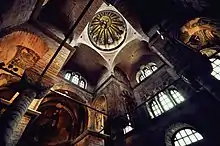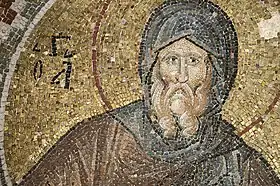Pammakaristos Church
The Pammakaristos Church, also known as the Church of Theotokos Pammakaristos (Greek: Θεοτόκος ἡ Παμμακάριστος, "All-Blessed Mother of God"), is one of the most famous Byzantine churches in Istanbul, Turkey, and was the last pre-Ottoman building to house the Ecumenical Patriarchate. Converted in 1591 into the Fethiye Mosque (Turkish: Fethiye Camii, "mosque of the conquest"), it is today partly a museum housed in a side chapel or parekklesion. One of the most important examples of Constantinople's Palaiologan architecture, the church contains the largest quantity of Byzantine mosaics in Istanbul after the Hagia Sophia and Chora Church.
| Pammakaristos Church | |
|---|---|
Μονή Παμμακάριστου Fethiye Camii | |
 Pammakaristos Church | |
| Religion | |
| Affiliation | Islam (currently) Greek Orthodox Church (previously) |
| Location | |
| Location | Istanbul, Turkey |
 Location within the Fatih district of Istanbul | |
| Geographic coordinates | 41°01′45″N 28°56′47″E |
| Architecture | |
| Type | Church |
| Style | Byzantine architecture, Greek architecture, Islamic |
| Minaret(s) | 2 |
| Website | |
| Official website | |
The church-mosque is in the Çarşamba neighbourhood of the Fatih district inside the walled city of Istanbul.
History

_-_Cupola_-_Foto_G._Dall'Orto_26-5-2006.jpg.webp)
_-_Foto_G._Dall'Orto_26-5-2006.jpg.webp)
_-_S._Antonio_-_Foto_G._Dall'Orto_26-5-2006.jpg.webp)

Most scholars believe that the church was built between the eleventh and twelfth centuries. Many historians and archaeologists attribute the original structure to Michael VII Ducas (1071–1078); others put its foundation in the Comnenian period.[1] Alternatively, the Swiss scholar and Byzantinist Ernest Mamboury suggested that the original building belonged to the 8th century.[2]
The parekklesion (side chapel) was added to the south side of the church in the early Palaiologan period, and dedicated to Christos ho Logos (Greek: Christ the Word).[3] Shortly after 1310, Martha Glabas erected a small shrine in memory of her late husband, the protostrator Michael Doukas Glabas Tarchaneiote, a general of Andronikos II Palaiologos.[4] An elegant dedicatory inscription to Christ, written by the poet Manuel Philes, runs along the inside and outside of the parekklesion.
The main church was also renovated at the same time, as the study of the Templon has shown.[4]
Following the fall of Constantinople in 1453, the seat of the Greek Orthodox Patriarchate was first moved from Hagia Sophia to the Church of the Holy Apostles. Then in 1456 it was moved to the Theotokos Pammakaristos Church, where it remained until 1587.[5]
Five years later, the Ottoman Sultan Murad III converted the church into a mosque and renamed it in honor of his conquest (fetih) of Georgia and Azerbaijan, hence the name Fethiye Camii. To accommodate the requirements of prayer, most of the interior walls were removed to create a larger inner space.
After years of neglect, the complex was restored in 1949 by the Byzantine Institute of America and Dumbarton Oaks.[1] While the main building remains a mosque, the parekklesion has been a museum since then.[6]
In 2021 restoration work on the building began again. It was due to be completed by the end of 2022.
Architecture and decoration
The Comnenian building was a church with a main aisle and two deambulatoria,[7] three apses, and a narthex to the west. The masonry was typical of the Comnenian period, and used the recessed brick technique. In this technique, alternate courses of brick are mounted behind the line of the wall, and are plunged in a mortar's bed, which can still be seen in the cistern underneath and in the church.[1]
The transformation of the church into a mosque greatly changed the original building. The arcades connecting the main aisle with the deambulatoria were removed and replaced with broad arches to open up the nave. The three apses were removed too. In their place towards the east a great domed room was built at an oblique angle to the orientation of the building.
On the other side, the parekklesion represents the most beautiful building of the late Byzantine period in Constantinople. It has the typical cross-in-square plan with five domes, but the proportion between vertical and horizontal dimensions is much bigger than usual (although not so big as in the contemporary Byzantine churches built in the Balkans).
Although the inner colored marble revetment largely disappeared, the shrine still contains the restored remains of a number of mosaic panels, which, while not as varied and well-preserved as those of the Chora Church, serve as another resource for understanding late Byzantine art.
A representation of the Pantocrator, surrounded by the prophets of the Old Testament (Moses, Jeremiah, Zephaniah, Micah, Joel, Zechariah, Obadiah, Habakkuk, Jonah, Malachi, Ezekiel, and Isaiah) fills the main dome. In the apse, Christ Hyperagathos is shown with the Virgin Mary and St. John the Baptist. A Baptism of Christ survives intact to the right side of the dome.
 Fethiye Museum exterior
Fethiye Museum exterior Fethiye Museum exterior
Fethiye Museum exterior Fethiye Museum Exterior
Fethiye Museum Exterior Fethiye Museum domes
Fethiye Museum domes Fethiye Museum mosaic in a dome
Fethiye Museum mosaic in a dome Fethiye Museum mosaic with Saint Antony, the desert Father
Fethiye Museum mosaic with Saint Antony, the desert Father Fethiye Museum mosaic of Saint Antony, the desert Father
Fethiye Museum mosaic of Saint Antony, the desert Father Fethiye Museum mosaic Christ
Fethiye Museum mosaic Christ Fethiye Museum mosaic Saint Gregory of Great Armenia
Fethiye Museum mosaic Saint Gregory of Great Armenia Fethiye Museum mosaic
Fethiye Museum mosaic Fethiye Museum capital
Fethiye Museum capital
In the building with the Fethiye Museum (with an entrance in the street passing the garden where the entrance to the museum is) a part is still a mosque. Here are some pictures of its interior
 Fethiye Mosque interior
Fethiye Mosque interior Fethiye Mosque interior
Fethiye Mosque interior Fethiye Mosque interior
Fethiye Mosque interior Fethiye Mosque interior
Fethiye Mosque interior Fethiye Mosque interior
Fethiye Mosque interior Fethiye Mosque interior
Fethiye Mosque interior
See also
Notes
- Mathews (1976), p. 346
- Mamboury, (1933)
- Mathews (1976), p. 347. Logos in the Eastern Orthodox Theology is the denomination of the second Person of the Trinity
- Mathews (1976), p. 347.
- Müller-Wiener (1977), p. 133.
- Entrance tickets, which up to some months ago had to be bought at Haghia Sophia, are now for sale at the parekklesion.
- A deambulatorium is an aisle which encircles the central part of a church
References
- Mamboury, Ernest (1933). Byzance - Constantinople - Istanbul (in French) (3 ed.). Istanbul: Milli Neşriyat Yurdu.
- Mathews, Thomas F. (1976). The Byzantine Churches of Istanbul: A Photographic Survey. University Park: Pennsylvania State University Press. ISBN 0-271-01210-2.
- Müller-Wiener, Wolfgang (1977). Bildlexikon zur Topographie Istanbuls: Byzantion, Konstantinupolis, Istanbul bis zum Beginn d. 17 Jh (in German). Tübingen: Wasmuth. ISBN 978-3-8030-1022-3.
- Belting, Hans; Mouriki, Doula; Mango, Cyril (1978). Mosaics and Frescoes of St Mary Pammakaristos (Fethiye Cami Istanbul). Dumbarton Oaks Pub Service. ISBN 0-88402-075-4.
- Harris, Jonathan (2007). Constantinople: Capital of Byzantium. Hambledon/Continuum. ISBN 978-1-84725-179-4.
_-_San_Gregorio_armeniaco_-_Foto_G._Dall'Orto_26-5-2006.jpg.webp)